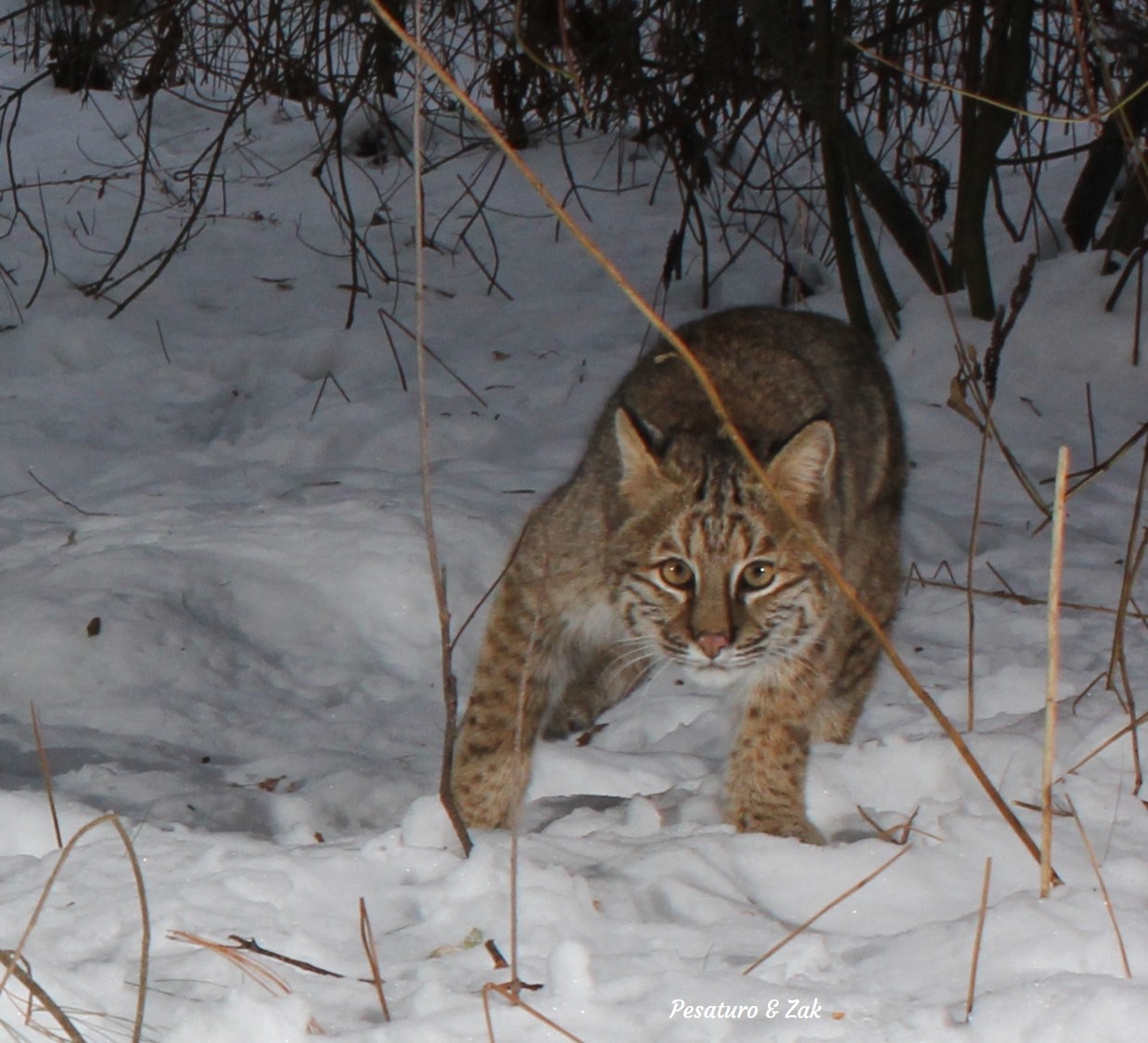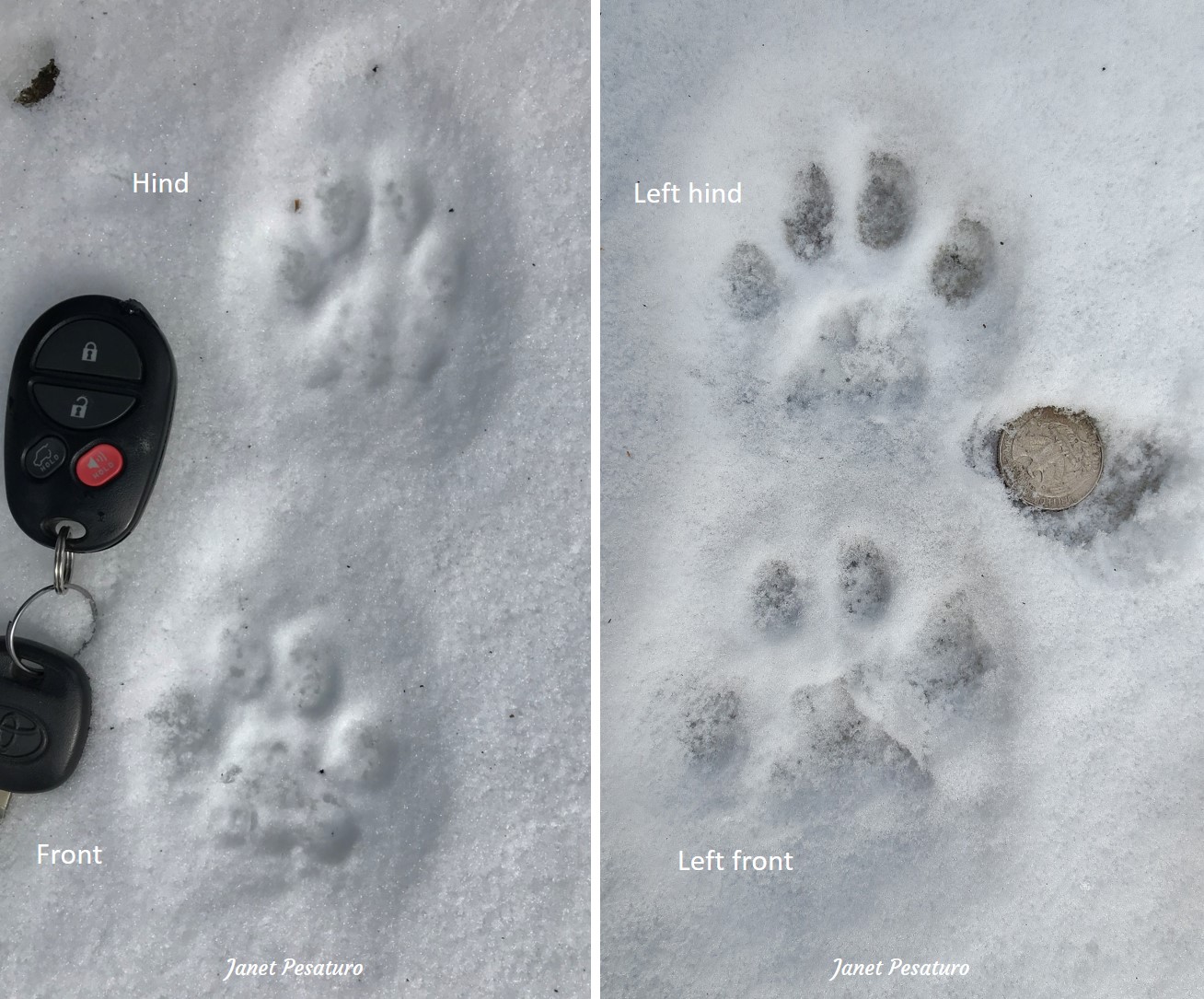
Though the bobcat (Lynx rufus) is common and widespread, it is usually shy and secretive so you are more likely to see its foot prints than the animal itself. Bobcat tracks and trail patterns (also called track patterns) are similar in appearance to those of the domestic cat, but their measurements are bigger…by about a factor of two. Once you have internalized the appearance of the tracks and trails, diagnosis is straightforward in excellent tracking conditions. But so often the tracks we find are indistinct and stretches of the trail are difficult or impossible to see. In that case, knowing something about bobcat behavior can help you determine the species, and in general can enhance your ability to interpret the story in the snow or sand or mud.
Bobcat Tracks and Trail Patterns: The Tracks
As I mentioned above, bobcat tracks look a lot of house cat tracks, except that they are about twice as large. The average width of a bobcat tracks is about 2 inches (with a range of about 1.5 – 2.5 inches). The characteristic features of the tracks are
- Overall track shape is roundish, especially the front tracks. Hind tracks are slightly elongated.
- Claw marks usually do not show, since cats often keep their claws retracted.
- The toe arrangement is asymmetric in a way that is similar to most human hands.
- The large pad, often called the heel or palm pad (but more properly called the metacarpal pad in front tracks and metatarsal pad in hind tracks):
- is large relative to the overall track
- is roughly shaped like a trapezoid
- has a bi-lobed leading edge
- has a tri-lobed back edge
- The negative space between the large pad and the toe pads is C-shaped.

It’s helpful to know those guidelines but remember that they are just guidelines. Don’t expect to find every feature present in every track. Substrate and aging can have a tremendous impact on track appearance. A typical distinction that must be made is feline vs. canine, and the ability to do that comes with experience. It can be simple and straightforward in good substrate but quite challenging in poor conditions. After studying many felid tracks and many canid tracks in different conditions your ability to make the distinction will improve.
Bobcat Tracks and Trail Patterns: The Patterns
Here I am referring to the pattern of tracks the animal leaves behind as it travels, so it is more properly called a track pattern, but for some reason “trail pattern” has become popular. Regardless of preferred terminology, it’s important to realize that most species can move in a variety of gaits and at a range of speeds, but each species has one or more typical or preferred gaits, and therefore commonly creates certain patterns. And even if you are new to tracking and don’t know anything about track patterns, you have seen house cats move and know they typically walk at a fairly relaxed pace. Bobcats are no different in that regard. The walking gait they use is called an alternating walk.
Direct Register Walking Pattern
In snow that’s at least a few inches deep, bobcats usually create a simple, easily recognized zig zagging pattern of tracks. This is because the hind tracks land directly on top of the front tracks. It’s called a direct register alternating walk. The step length, or distance between one track and the next, is around 6-14 inches and the trail width is 4-9 inches.
Overstep and Understep Walking Patterns
In firm or shallow substrate, walking bobcats often overstep, meaning that hind tracks land ahead of the front tracks. This overstep pattern can be tricky to distinguish from other track patterns, so it’s helpful to study it carefully and determine which tracks are front and which are hind. Also realize that the appearance of the track pattern differs if the cat oversteps just a little vs. a lot. In the examples below, the overstep is slightly larger in the photo at left.
Be careful when analyzing bobcat walk patterns and do not assume that every time it does not direct register, it is overstepping. Occasionally they do understep. In an understep the hind foot lands behind the front foot. Basically, an overstep is associated with a faster pace and an understep is associated with a slower pace.
One situation in which a bobcat may move in an understep walk is while stalking. This makes intuitive sense, because cats usually move slowly when stalking. In the video below, you can see a bobcat direct registering, overstepping, and understepping. And indeed, the understep occurs while the cat is stalking.
Factoring in Behavior
Knowledge of animal behavior is hugely helpful when tracking. It can help you to understand why the tracks and trails appear as they do, to tip the balance toward one species or another, to predict what the animal might do next, etc. Stalking is one example, already discussed. Another example is the bobcat’s tendency to sit down to look around for hunting opportunities. Bobcats do this quite frequently, and in soft substrate you may see sit down prints.
An awareness of seasonal behaviors is also helpful. For example, bobcats mate in winter to early spring, the female gives birth in spring, and kittens remain with their mother into the fall and occasionally the winter. Now check out the next photo of bobcat tracks I found one February while following the trails of two cats walking together. The neat walking trails I was initially following converged and exploded into the jumble of tracks shown below. Most likely this was a male and female in courtship, but it’s also possible that it was a mother and her youngster from the previous spring, or even two juvenile littermates still associating with one another.
In summer or fall, on the other hand, the trails of two cats converging into a mess of tracks would more likely represent a pair of kittens playing or a mother and kitten playing. I’ve been lucky enough to get bobcats playing on a couple of trail camera videos – see below.
Another bobcat behavior that the tracker will undoubtedly encounter is scent marking. I have already posted here about bobcats scent marking behavior as seen on video, and a future post will focus on finding and recognizing bobcat scent posts.
What are your questions, observations, or tips on recognizing bobcat tracks and trail patterns? Share your thoughts in a comment below.
For a large gallery of bobcat tracks in different substrate conditions, check out this site.











































